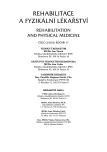Principles of Rehabilitation Management in Occupational Pneumopathies from the ICF Point of View
Authors:
A. Kubincová 1; P. Takáč 1; Ľ. Legáth 2
Authors‘ workplace:
Klinika fyziatrie, balneológie a liečebnej rehabilitácie LF UPJŠ a FN LP, Košice
prednosta doc. MUDr. P. Takáč, Ph. D.
1; Klinika pracovného lekárstva a klinickej toxikológie LF UPJŠ a FN LP, Košice
prednosta doc. MUDr. Ľ. Legáth, CSc.
2
Published in:
Rehabil. fyz. Lék., 17, 2010, No. 3, pp. 101-106.
Category:
Original Papers
Overview
Lung rehabilitation is an integral part of clinical management and protection of the health of patients with chronic lung diseases, where lung impairment is present. The most powerful demonstration of efficiency of lung rehabilitation programs come from well established randomized control studies in chronic obstructive bronchopulmonary disease. Lung rehabilitation is indicated in patients with obstructive, restrictive and other pulmonary diseases. Occupational damage to the respiration system represents an extensive group of diseases caused particularly by environmental effects of working environment. The occurrence of comorbidities is characteristic in these patients. In view of the systemic defect, comorbidity and age there is a key role of evaluating the patient condition for creating an individual rehabilitation plan. The approved International Classification of Function, Disability and Health (ICF) makes it possible to evaluate the patient in a complex way at the level of body function disorders body structures, limitations of activity and environmental factors. The evaluation of components of ICF classification makes an individual approach possible as well as establishment of a comprehensive lung rehabilitation program.
Key words:
comprehensive lung rehabilitation, occupational pneumopathies, comorbidity, ICF, functional evaluation
Sources
1. AARC Clinical Practice Guideline Pulmonary Rehabilitation. Pulmonary Rehabilitation Respiratory Care, roč. 37, 2002, č. 5, s. 617-625.
2. BOSCHETTO, P., QUINTAVALLE, S.,MIOTTO, D., LO CASCIO, N., ZENI, E., MAPP, CH. E.: Chronic obstructive pulmonary disease (COPD) and occupational exposures. Journal of Occupational Medicine and Toxicology, 2006, s. 1-11.
3. BOURBEAU, J., NAULT, D., BORYCKI, E.: Comprehensive management of chronic obstructive pulmonary disease. Hamilton, London, BC Decker, Inc., 2002, 372 s., ISBN 1-55009-174-3.
4. CRISAFULLI, E., COSTI, S., LUPPI, F., CIRELLI, G., CILIONE, C., COLETTI, O., FABBRI, L. M., CLINI, E. M.: Chronic obstructive pulmonary disease role of comorbidities in a cohort of patients with COPD undergoing pulmonary rehabilitation. Thorax, roč. 63, 2008, s. 487-492.
5. GOLD - Global Initiative for Chronic Obstructive Lung Disease. Global Strategy for the diagnosis, management and prevention of Chronic Obstructive Pulmonary Disease, 2006.[on line] MCR VISION Inc. 88.[citované 15-06-07]. Dostupné na: www.goldcopd.org
6. JANAUDIS-FERREIRA, T., HILL, K., GOLDSTEIN, R., WADELL, K., BROOKS, D.: Arm exercise training in patients with chronic obstructive pulmonary disease: a systematic review. J. Cardiopulm Rehabil. Prev., roč. 29, č. 5, 2009, s. 277-283.
7. KAGAYA, H., TAKAHASHI, H., SUGAWARA, K., KASAI, CH., KIYOKAWA, N., SHIOYA, T.: Effective home-based pulmonary rehabilitation in patients with restrictive lung diseases. Tohoku J. Exp. Med., roč. 218, 2009, s. 215-219.
8. MAGDER, S. et al.: Cardiac arrhythmias during exercise in severe chronic obstructive pulmonary disease. Chest, roč. 97, 1990, s. 793-797 .
9. Národné centrum zdravotníckych informácií: Choroby z povolania alebo ohrozenia chorobou z povolania v SR 2009. Bratislava, roč. 2010 ZŠ-6/2009, v tlači.
10. NICI L. et al.: American thoracic society/European Respiratory Society Statement on Pulmonary Rehabilitation. American Journal of Respiratory and Critical Care Medicine, roč. 173, 2006, s. 1390-1413.
11. PAPIRIS, S. A., DANIIL, Z. D., MALAGARI, K., KAPOTSIS, G. E., SOTIROPOULOU, C., MILIC-EMILI, J., ROUSSOS, C.: The Medical Research Council dyspnea scale in the estimation of disease severity in idiopathic pulmonary fibrosis. Respir. Med., roč. 6, 2005, č. 99, s. 755-761.
12. RIES, A. L. et al.: Pulmonary rehabilitation* joint ACCP/ /AACVPR evidence-based clinical practice guidelines. Chest, roč. 131, 2007, č. 5, s. 4-42.
13. SANGHA, O. et al.: The eelf-administered comorbidity questionnaire: A new method to assess comorbidity for clinical and health services research. Arthritis & Rheumatism (Arthritis Care & Research), roč. 49, 2003, č. 2, s. 156-163.
14. SHARMA, S.: Pulmonary rehabilitation. [on line] 22. 4. 2010 [citované: 30-05-2010]. Dostupné na:
http://www.emedicine.com/pmr/topic181.htm.
15. SMOLÍKOVÁ, L., MÁČEK, M..: Fyzioterapie a pohybová léčba u chronických plicních onemocnění. Praha, Blue Wings, 2006, 219 s.
16. STUCKI, A., STOLL, T., CIEZA, A. ,WEIGL, M., GIARDINI, A., WEVER, D., KOSTANJSEKAND, N., STUCKI, G.: ICF core sets for obstructive pulmonary diseases. J Rehabil. Med., 44 (Suppl.), 2004, s. 114-120.
17. THEANDER, K., CLIFFORDSON, CH., TORSTENSSON, O., JAKOBSSON, P., UNOSSON, M.: Fatigue impact scale: Its validation in patients with chronic obstructive pulmonary disease. Psychology, Health & Medicine, roč. 12, 2007, č. 4, s. 470-484.
18. VIEGI, G., DI PEDE, C.: Chronic obstructive lung diseases and occupational exposure. Current Opinion in Allergy & Clinical Immunology, roč. 2, 2002, č. 2, s. 115-121.
19. World Health Organization: International Classi?cation of Functioning, Disability and Health: ICF. Geneva: WHO; 2001.
20. YOUNG, R. C., RACHAL, R. E.: Pulmonary disability in former appalachian coal miners. Journal of the National Medical Association, roč. 88, 1996, č. 8, s. 517-522.
Labels
Physiotherapist, university degree Rehabilitation Sports medicineArticle was published in
Rehabilitation & Physical Medicine

2010 Issue 3
Most read in this issue
- Tietze’s Syndrome Versus Multiple Myeloma
- Clinical Study of High-induction Electromagnetic Stimulator SALUS Talent
- Rehabilitation in Orofacial Region in Cases of Central Paresis of Facial Nerve
- Application of Electrotherapeutic Currents of the TENS Type in Physiotherapy
